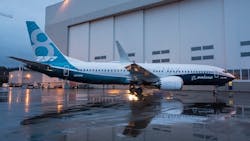New orders for U.S. durable goods picked up in January after losing ground for two straight months, in a sign of strength among US manufacturers.
New orders for long-lived manufactured goods jumped 4.9% in January to $237.5 billion, with the main contribution to the surge coming from the civilian aircraft sector, essentially from Boeing (IW 1000/40). New aircraft orders surged 54.2%.
Auto orders were also strong increasing 3%.
But stripping out transportation items, durable goods orders still managed a 1.8% gain in the month, more than compensating for the falls of November and December.
Orders for both machinery and computers rose more than 6%.
Another sign of improvement in a sector that has been hit by the global slowdown and, for exporters, the strong dollar, was that manufacturers' inventories fell 0.1% in January after a December rise, and that inventories excluding transportation were down 0.4%.
“While providing something of a respite from the increasingly gloomy global and U.S. economic climate, the report continues to reveal a stubborn weakness in capital investment behavior,” explains Cliff Waldman, director of economic studies at the MAPI Foundation.
“ Total new orders were up by a modest 0.6% over January 2015. Excluding transportation, they were down by 2.5% over year-ago levels. Key subsectors that have wide-ranging intersections with manufacturing supply chains, such as primary metals, fabricated metals, and machinery, also saw a bounce-back from December weakness but were nonetheless disconcertingly below January 2015 levels. Most notably, new orders in the primary metals subsector were 15.6% below last year’s performance.
”Of importance to broad economic welfare, new orders for non-defense capital goods excluding aircraft, a proxy for business equipment spending, rose 3.9% in January after a 3.7% contraction in December. In parallel with other components of the January report, they were 4.4% below January 2015 levels. Financial market volatility and escalating concerns about the health of the U.S. and global economies create a decidedly negative climate for business investment, a variable that has experienced stubborn weakness for more than 15 years and has been one impediment to the post–Great Recession resumption of historically normal growth in the U.S.
“With recent data revealing a slowdown in the U.S., key economies outside of the U.S. either in or near recession, and the continued strength of the dollar, the outlook for U.S. manufacturing performance remains murky and surrounded by downside risks. Calendar year 2016 is unlikely to be a strong one for the U.S. factory sector, although output should accelerate modestly during 2017 and 2018.”
Copyright, Agence France-Presse, 2016
About the Author
Agence France-Presse
Copyright Agence France-Presse, 2002-2025. AFP text, photos, graphics and logos shall not be reproduced, published, broadcast, rewritten for broadcast or publication or redistributed directly or indirectly in any medium. AFP shall not be held liable for any delays, inaccuracies, errors or omissions in any AFP content, or for any actions taken in consequence.
